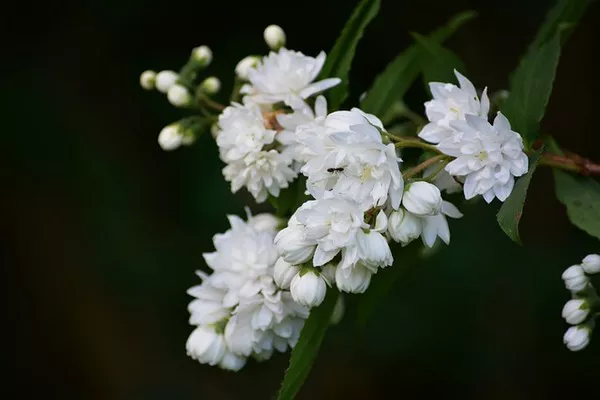In the vast tapestry of floral symbolism, few blooms carry the enigmatic allure and profound significance of the jasmine flower. Revered across cultures and civilizations for centuries, the jasmine flower transcends mere botanical beauty to embody a rich tapestry of meanings, emotions, and cultural expressions. From its delicate petals to its intoxicating fragrance, the jasmine flower holds a unique place in human history, literature, and spiritual practices. Let us embark on a journey to unravel the intricate layers of symbolism and meaning hidden within this exquisite blossom.
Origins and Botanical Characteristics
Before delving into its symbolic significance, understanding the physical attributes and origins of the jasmine flower provides a solid foundation. Belonging to the genus Jasminum, the jasmine flower encompasses over 200 species of flowering plants in the Oleaceae family. Native to tropical and subtropical regions of Eurasia, Australasia, and Oceania, jasmine plants are characterized by their fragrant white or yellow blossoms and glossy green leaves.
Among the various species, Jasminum officinale, commonly known as common jasmine or true jasmine, holds particular cultural and symbolic significance. Renowned for its intensely fragrant white flowers, Jasminum officinale has been cultivated and revered for its aromatic properties and ornamental value across diverse cultures.
Cultural and Historical Significance
The jasmine flower’s cultural significance traces back thousands of years, weaving its way through the annals of history and mythology. In ancient Persia, jasmine symbolized love, sensuality, and romance, often adorning wedding ceremonies and bridal attire as a token of purity and eternal love. The association of jasmine with love and passion persisted through the ages, finding expression in art, poetry, and literature across the Middle East and beyond.
In Indian culture, jasmine holds profound spiritual significance and is regarded as the “queen of flowers.” Revered as a sacred offering to Hindu deities, jasmine garlands adorn temples, rituals, and religious ceremonies, symbolizing purity, auspiciousness, and devotion. The fragrant presence of jasmine is believed to purify the mind, elevate consciousness, and invite blessings from the divine.
Similarly, in Chinese and Southeast Asian traditions, jasmine is revered for its auspicious symbolism and therapeutic properties. Jasmine tea, brewed from jasmine-scented green tea leaves, has been cherished for centuries for its calming effects on the body and mind, symbolizing harmony, tranquility, and rejuvenation.
Symbolism and Meanings
Beyond its cultural and historical significance, the jasmine flower embodies a myriad of symbolic meanings that resonate deeply with human experiences and emotions. Central to its symbolism is the fragrance of jasmine, renowned for its heady, intoxicating aroma that evokes feelings of joy, sensuality, and euphoria.
In the language of flowers, jasmine conveys messages of love, romance, and desire, making it a popular choice for romantic gestures and expressions of affection. Whether exchanged as a bouquet or worn as a fragrant adornment, jasmine serves as a timeless symbol of passion, devotion, and eternal love.
Furthermore, the purity and innocence associated with the white jasmine blossom have led to its symbolic representation of purity, chastity, and spiritual enlightenment. In various religious and cultural contexts, jasmine is used to evoke states of inner purity, transcendence, and spiritual awakening, guiding seekers on the path towards enlightenment and self-realization.
Moreover, the delicate nature of jasmine flowers, which bloom only at night and wither by dawn, symbolizes the fleeting beauty of life and the transient nature of existence. This ephemeral quality imbues jasmine with a sense of melancholy and nostalgia, reminding us to cherish the precious moments of beauty and joy in our lives.
Jasmine in Literature and Art
Throughout history, the jasmine flower has captivated the imaginations of poets, artists, and writers, inspiring countless works of literature, art, and music. From Shakespeare’s references to jasmine in “A Midsummer Night’s Dream” to the evocative imagery of jasmine-scented gardens in Persian poetry, the flower’s presence in cultural expressions is ubiquitous.
In visual arts, jasmine blossoms feature prominently in traditional paintings, tapestries, and decorative arts across Asia and the Middle East, symbolizing beauty, elegance, and femininity. The intricate motifs of jasmine vines and flowers adorn textiles, pottery, and architectural ornamentation, reflecting the enduring allure of this fragrant blossom.
Modern Applications and Cultivation
In contemporary times, the allure of jasmine continues to captivate enthusiasts and horticulturists worldwide, leading to widespread cultivation and commercialization of jasmine plants for their ornamental and aromatic qualities. From perfumery and aromatherapy to culinary applications and herbal medicine, jasmine finds diverse uses in modern society, reflecting its enduring appeal and versatility.
In the realm of perfumery, jasmine is prized as a coveted ingredient for its rich, floral fragrance and aphrodisiac properties. The essence of jasmine, extracted through solvent extraction or enfleurage, forms the heart of many iconic perfumes and fragrances, imparting a sense of luxury, sensuality, and sophistication.
Furthermore, jasmine essential oil is valued in aromatherapy for its calming, antidepressant, and aphrodisiac effects, promoting relaxation, emotional balance, and heightened sensory experiences. Whether diffused in the air, applied topically, or added to bath products, jasmine oil offers a holistic approach to well-being and self-care.
In culinary traditions, jasmine flowers are used to impart delicate floral notes and aromatic flavors to teas, desserts, and savory dishes. Jasmine-infused green tea, jasmine rice, and jasmine-scented desserts are popular delicacies enjoyed for their fragrant allure and subtle taste profile.
Conclusion
In conclusion, the jasmine flower transcends its botanical origins to become a potent symbol of love, purity, and transcendence that resonates across cultures, religions, and artistic expressions. From ancient rituals and spiritual practices to modern perfumery and cuisine, jasmine continues to weave its fragrant mystique into the fabric of human experience, reminding us of the enduring power of beauty, love, and transformation. As we inhale the intoxicating fragrance of jasmine, let us embrace the profound meanings and emotions it evokes, enriching our lives with its timeless allure and symbolic resonance.


